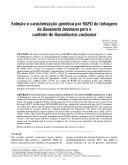| dc.description.abstract | La patogenicidad de veintidos linajes de Beauveria bassiana fue probada sobre adultos de Homalinotus coriaceus, cuyas larvas atacan el pedúnculo floral del coquero, ocasionando la caída de las flores y de los frutos inmaduros. El trabajo se desarrolló en Embrapa-CPATC y Embrapa-CENARGEM, siguiendo un diseño experimental completamente aleatorizado, con 23 tratamientos (22 linajes y un testigo) y cinco repeticiones, cada una con 20 insectos adultos. La prueba de patogenicidad fue realizada por la inmersión de adultos de H. coriaceus en suspensión conidial (10 exponente 9 conidios/mL). Los aislados fueron caracterizados genéticamente por RAPD, utilizando 16 imprimadores. Los linajes seleccionados, con patogenicidad superior a 80 porciento, fueron: CG002, CG544, CG817, CG557 y CG219. La caracterización genética indicó correlación entre el dendrograma y la matriz, con una similitud de 95 porciento. El linaje más patogénico (CG002) presentó 67 porciento de similitud con el cuarto linaje más patogénico (CG817), mientras que los demás linajes seleccionados presentaron una similitud menor al 67 porciento. Los análisis de RAPD no produjeron grupos bien definidos, concluyéndose que la virulencia de B. bassiana a H. coriaceus no tiene relación con la similitud genética verificada entre los linajes. The patogenicity of twenty-two Beauveria bassiana strains was evaluated against adults of Homalinotus coriaceus (Coleoptera: Curculionidae), an important coconut pest in Brazil whose larvae attack the bunch, causing the flowers and the immature fruits to fall down. The research was carried out in Embrapa-CPATC and Embrapa-CENARGEM, following a completely randomized design, with 23 treatments (22 strains and a blank) and five replications, with 20 adult insects each. The pathogenicity test was carried out by immersing H. coriaceus adults in a conidial suspension (10 exponent 9 conidia/mL). The strains were genetically identified through RAPD, using 16 primers. The strains with a patogenicity of over 80 percent were: CG002, CG544, CG817, CG557, and CG219.The genetic characterization showed a correlation of 95 percent between the dendogram and the similarity matrix. The most pathogenic strain (CG002) showed a similarity of 67 percent with the fourth one (CG817). The other strains showed a similarity of under 67 percent. The RAPD analysis did not show well-defined groups, and we conclude that B. bassiana virulence to H. coriaceus is not correlated with genetic similarity between strains. | es_ES |


